Luminous Read online
Page 8
I headed back to the hotel, pushing my way through the relentless crowds, half seduced and half sickened by the odours of cooking, dazed by the endless vista of holograms and neon in a language I barely understood. Fifteen minutes later, reeling from the noise and humidity, I realised that I was lost.
I stopped on a street corner and tried to get my bearings. Shanghai stretched out around me, dense and lavish, sensual and ruthless – a Darwinian economic simulation self-organised to the brink of catastrophe. The Amazon of commerce: this city of sixteen million had more industry of every kind, more exporters and importers, more wholesalers and retailers, traders and re-sellers and recyclers and scavengers, more billionaires and more beggars, than most nations on the planet.
Not to mention more computing power.
China itself was reaching the cusp of its decades-long transition from brutal totalitarian communism to brutal totalitarian capitalism: a slow seamlesss morph from Mao to Pinochet set to the enthusiastic applause of its trading partners and the international financial agencies. There’d been no need for a counter-revolution – just layer after layer of carefully reasoned Newspeak to pave the way from previous doctrine to the stunningly obvious conclusion that private property, a thriving middle class, and a few trillion dollars’ worth of foreign investment were exactly what the Party had been aiming for all along.
The apparatus of the police state remained as essential as ever. Trade unionists with decadent bourgeois ideas about uncompetitive wages, journalists with counter-revolutionary notions of exposing corruption and nepotism, and any number of subversive political activists spreading destabilising propaganda about the fantasy of free elections, all needed to be kept in check.
In a way, Luminous was a product of this strange transition from communism to not-communism in a thousand tiny steps. No one else, not even the US defence research establishment, possessed a single machine with so much power. The rest of the world had succumbed long ago to networking, giving up their imposing supercomputers with their difficult architecture and customised chips for a few hundred of the latest mass-produced work stations. In fact, the biggest computing feats of the twenty-first century had all been farmed out over the Internet to thousands of volunteers, to run on their machines whenever the processors would otherwise be idle. That was how Alison and I had mapped the defect in the first place: seven thousand amateur mathematicians had shared the joke, for twelve years.
But now the net was the very opposite of what we needed, and only Luminous could take its place. And though only the People’s Republic could have paid for it, and only the People’s Institute for Advanced Optical Engineering could have built it … only Shanghai’s QIPS Corporation could have sold time on it to the world – while it was still being used to model hydrogen-bomb shock waves, pilotless fighter jets, and exotic anti-satellite weapons.
I finally decoded the street signs, and realised what I’d done: I’d turned the wrong way coming out of the emporium, it was as simple as that.
I retraced my steps, and I was soon back on familiar territory.
* * *
When I opened the door of my room, Alison was sitting on the bed.
I said, ‘What is it with locks in this city?’
We embraced, briefly. We’d been lovers, once, but that was long over. And we’d been friends for years afterwards, but I wasn’t sure if that was still the right word. Our whole relationship now was too functional, too spartan. Everything revolved around the defect, now.
She said, ‘I got your message. What happened?’
I described the morning’s events.
‘You know what you should have done?’
That stung. ‘I’m still here, aren’t I? The cargo’s still safe.’
‘You should have killed her, Bruno.’
I laughed. Alison gazed back at me placidly, and I looked away. I didn’t know if she was serious – and I didn’t much want to find out.
She helped me apply the repair cream. My toxin was no threat to her: we’d both installed exactly the same symbionts, the same genotype from the same unique batch in Hanoi. But it was strange to feel her bare fingers on my broken skin, knowing that no one else on the planet could touch me like this, with impunity.
Ditto for sex, but I didn’t want to dwell on that.
As I slipped on my jacket, she said, ‘So guess what we’re doing at five a.m. tomorrow.’
‘Don’t tell me: I fly to Helsinki, and you fly to Cape Town? Just to throw them off the scent.’
That got a faint smile. ‘Wrong. We’re meeting Yuen at the Institute – and spending half an hour on Luminous.’
‘You are brilliant.’ I bent over and kissed her on the forehead. ‘But I always knew you’d pull it off.’
And I should have been delirious, but the truth was my guts were churning; I felt almost as trapped as I had upon waking cuffed to the bed. If Luminous had remained beyond our reach (as it should have, since we couldn’t afford to hire it for a microsecond at the going rate) we would have had no choice but to destroy all the data, and hope for the best. Industrial Algebra had no doubt dredged up a few thousand fragments of the original Internet calculations, but it was clear that, although they knew exactly what we’d found, they still had no idea where we’d found it. If they’d been forced to start their own random search – constrained by the need for secrecy to their own private hardware – it might have taken them centuries.
There was no question now, though, of backing away and leaving everything to chance. We were going to have to confront the defect in person.
‘How much did you have to tell him?’
‘Everything.’ She walked over to the washbasin, removed her shirt, and began wiping the sweat from her neck and torso with a flannel. ‘Short of handing over the map. I showed him the search algorithms and their results, and all the programs we’ll need to run on Luminous – all stripped of specific parameter values, but enough for him to validate the techniques. He wanted to see direct evidence of the defect, of course, but I held out on that.’
‘And how much did he believe?’
‘He’s reserved judgement. The deal is, we get half an hour’s unimpeded access, but he gets to observe everything we do.’
I nodded, as if my opinion made any difference, as if we had any choice. Yuen Ting-fu had been Alison’s supervisor for her PhD on advanced applications of ring theory, when she’d studied at Fu-tan University in the late nineties. Now he was one of the world’s leading cryptographers, working as a consultant to the military, the security services, and a dozen international corporations. Alison had once told me that she’d heard he’d found a polynomial-time algorithm for factoring the product of two primes; that had never been officially confirmed, but such was the power of his reputation that almost everyone on the planet had stopped using the old RSA encryption method as the rumour had spread. No doubt time on Luminous was his for the asking, but that didn’t mean he couldn’t still be imprisoned for twenty years for giving it away to the wrong people, for the wrong reasons.
I said, ‘And you trust him? He may not believe in the defect now, but once he’s convinced—’
‘He’ll want exactly what we want. I’m sure of that.’
‘OK. But are you sure IA won’t be watching, too? If they’ve worked out why we’re here, and they’ve bribed someone—’
Alison cut me off impatiently. ‘There are still a few things you can’t buy in this city. Spying on a military machine like Luminous would be suicidal. No one would risk it.’
‘What about spying on unauthorised projects being run on a military machine? Maybe the crimes cancel out, and you end up a hero.’
She approached me, half naked, drying her face on my towel. ‘We’d better hope not.’
I laughed suddenly. ‘You know what I like most about Luminous? They’re not really letting Exxon and McDonnell-Douglas use the same machine as the People’s Liberation Army. Because the whole computer vanishes every time they pull the plug. Th
ere’s no paradox at all, if you look at it that way.’
* * *
Alison insisted that we stand guard in shifts. Twenty-four hours earlier, I might have made a joke of it; now I reluctantly accepted the revolver she offered me, and sat watching the door in the neon-tinged darkness while she went out like a light.
The hotel had been quiet for most of the evening, but now it came to life. There were footsteps in the corridor every five minutes – and rats in the walls, foraging and screwing and probably giving birth. Police sirens wailed in the distance; a couple screamed at each other in the street below. I’d read somewhere that Shanghai was now the murder capital of the world – but was that per capita, or in absolute numbers?
After an hour, I was so jumpy that it was a miracle I hadn’t blown my foot off. I unloaded the gun, then sat playing Russian roulette with the empty barrel. In spite of everything, I still wasn’t ready to put a bullet in anyone’s brain for the sake of defending the axioms of number theory.
* * *
Industrial Algebra had approached us in a perfectly civilised fashion. They were a small but aggressive UK-based company, designing specialised high-performance computing hardware for industrial and military applications. That they’d heard about the search was no great surprise – it had been openly discussed on the Internet for years, and even joked about in serious mathematical journals – but it seemed an odd coincidence when they made contact with us just days after Alison had sent me a private message from Zürich mentioning the latest ‘promising’ result. After half a dozen false alarms – all due to bugs and glitches – we’d stopped broadcasting the news of every unconfirmed find to the people who were donating runtime to the project, let alone any wider circle. We were afraid that if we cried wolf one more time, half our collaborators would get so annoyed that they’d withdraw their support.
IA had offered us a generous slab of computing power on the company’s private network – several orders of magnitude more than we received from any other donor. Why? The answer kept changing. Their deep respect for pure mathematics … their wide-eyed fun-loving attitude to life … their desire to be seen to be sponsoring a project so wild and hip and unlikely to succeed that it made SETI look like a staid blue-chip investment. It was, they’d finally ‘conceded’, a desperate bid to soften their corporate image after years of bad press for what certain unsavoury governments did with their really rather nice smart bombs.
We’d politely declined. They’d offered us highly paid consulting jobs. Bemused, we’d suspended all net-based calculations – and started encrypting our mail with a simple but highly effective algorithm Alison had picked up from Yuen.
Alison had been collating the results of the search on her own work station at her current home in Zürich, while I’d helped co-ordinate things from Sydney. No doubt IA had been eavesdropping on the incoming data, but they’d clearly started too late to gather the information needed to create their own map; each fragment of the calculations meant little in isolation. But when the work station was stolen (all the files were encrypted, it would have told them nothing) we’d finally been forced to ask ourselves: If the defect turns out to be genuine, if the joke is no joke … then exactly what’s at stake? How much money? How much power?
On 7 June 2006, we met in a sweltering, crowded square in Hanoi. Alison wasted no time. She was carrying a backup of the data from the stolen work station in her notepad and she solemnly proclaimed that, this time, the defect was real.
The notepad’s tiny processor would have taken centuries to repeat the long random trawling of the space of arithmetic statements which had been carried out on the net, but, led straight to the relevant computations, it could confirm the existence of the defect in a matter of minutes.
The process began with Statement S. Statement S was an assertion about some ludicrously huge numbers, but it wasn’t mathematically sophisticated or contentious in any way. There were no claims here about infinite sets, no propositions concerning ‘every integer’. It merely stated that a certain (elaborate) calculation performed on certain (very large) whole numbers led to a certain result – in essence, it was no different from something like ‘5+3 = 4×2’. It might have taken me ten years to check it with a pen and paper, but I could have carried out the task with nothing but primary-school mathematics and a great deal of patience. A statement like this could not be undecidable; it had to be either true or false.
The notepad decided it was true.
Then the notepad took statement S … and, in 423 simple, impeccably logical steps, used it to prove not-S.
I repeated the calculations on my own notepad, using a different software package. The result was exactly the same. I gazed at the screen, trying to concoct a plausible reason why two different machines running two different programs could have failed in identical ways. There’d certainly been cases in the past of a single misprinted algorithm in a computing textbook spawning a thousand dud programs. But the operations here were too simple, too basic.
Which left only two possibilities. Either conventional arithmetic was intrinsically flawed, and the whole Platonic ideal of the natural numbers was ultimately self-contradictory; or Alison was right, and an alternative arithmetic had come to hold sway in a ‘computationally remote’ region, billions of years ago.
I was badly shaken, but my first reaction was to try to play down the significance of the result. ‘The numbers being manipulated here are greater than the volume of the observable universe, measured in cubic Planck lengths. If IA were hoping to use this on their foreign-exchange transactions, I think they’ve made a slight error of scale.’ Even as I spoke, though, I knew it wasn’t that simple. The raw numbers might have been trans-astronomical, but it was the mere 1,024 bits of the notepad’s binary representations which had actually, physically misbehaved. Every truth in mathematics was encoded, reflected, in countless other forms. If a paradox like this – which at first glance sounded like a dispute about numbers too large to apply even to the most grandiose cosmological discussions – could affect the behaviour of a five-gram silicon chip, then there could easily be a billion other systems on the planet at risk of being touched by the very same flaw.
But there was worse to come.
The theory was, we’d located part of the boundary between two incompatible systems of mathematics, both of which were physically true, in their respective domains. Any sequence of deductions which stayed entirely on one side of the defect – whether it was the ‘near side’, where conventional arithmetic applied, or the ‘far side’, where the alternative took over – would be free from contradictions. But any sequence which crossed the border would give rise to absurdities: hence S could lead to not-S.
So, by examining a large number of chains of inference, some of which turned out to be self-contradictory and some not, it should have been possible to map the area around the defect precisely – to assign every statement to one system or the other.
Alison displayed the first map she’d made. It portrayed an elaborately crenellated fractal border, rather like the boundary between two microscopic ice crystals – as if the two systems had been diffusing out at random from different starting points, and then collided, blocking each other’s way. By now, I was almost prepared to believe that I really was staring at a snapshot of the creation of mathematics – a fossil of primordial attempts to define the difference between truth and falsehood.
Then she produced a second map of the same set of statements, and overlaid the two. The defect, the border, had shifted – advancing in some places, retreating in others.
My blood went cold. ‘That has got to be a bug in the software.’
‘It’s not.’
I inhaled deeply, looking around the square – as if the heedless crowd of tourists and hawkers, shoppers and executives, might offer some simple ‘human’ truth more resilient than mere arithmetic. But all I could think of was 1984: Winston Smith, finally beaten into submission, abandoning every touchstone of reason b
y conceding that two and two make five.
I said, ‘OK. Go on.’
‘In the early universe, some physical system must have tested out mathematics which was isolated, cut off from all the established results, leaving it free to decide the outcome at random. That’s how the defect arose. But by now, all the mathematics in this region has been tested, all the gaps have been filled in. When a physical system tests a theorem on the near side, not only has it been tested a billion times before, but all the logically adjacent statements around it have been decided, and they imply the correct result in a single step.’
‘You mean … peer pressure from the neighbours? No inconsistencies allowed, you have to conform? If x−1= y−1, and x+1 = y+1, then x is left with no choice but to equal y because there’s nothing ‘‘near by’’ to support the alternative?’
‘Exactly. Truth is determined locally. And it’s the same, deep into the far side. The alternative mathematics has dominated there, and every test takes place surrounded by established theorems which reinforce each other, and the ‘‘correct’’ – nonstandard – result.’
‘At the border, though—’
‘At the border, every theorem you test is getting contradictory advice. From one neighbour, x−1= y−1 … but, from another, x+1 = y+2. And the topology of the border is so complex that a near-side theorem can have more far-side neighbours than near-side ones – and vice versa.
‘So the truth at the border isn’t fixed, even now. Both regions can still advance or retreat. It all depends on the order in which the theorems are tested. If a solidly near-side theorem is tested first, and it lends support to a more vulnerable neighbour, that can guarantee that they both stay near-side.’ She ran a brief animation which demonstrated the effect. ‘But if the order is reversed, the weaker one will fall.’

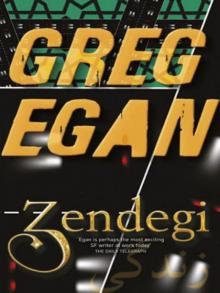 Zendegi
Zendegi Permutation City
Permutation City The Eternal Flame
The Eternal Flame Artifacts
Artifacts Wang's Carpets
Wang's Carpets Dichronauts
Dichronauts Incandescence
Incandescence Teranesia
Teranesia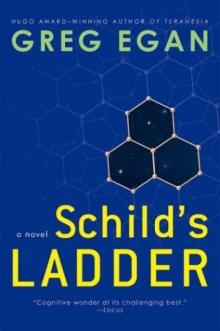 Schild's Ladder
Schild's Ladder Quarantine
Quarantine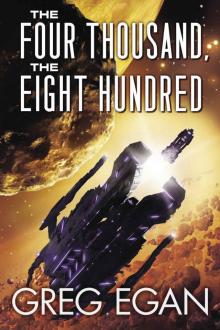 The Four Thousand, the Eight Hundred
The Four Thousand, the Eight Hundred The Clockwork Rocket
The Clockwork Rocket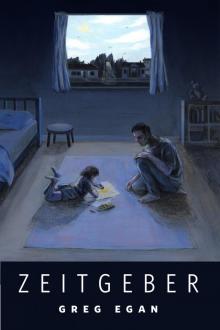 Zeitgeber
Zeitgeber Phoresis
Phoresis The Nearest
The Nearest Diaspora
Diaspora Instantiation
Instantiation Distress
Distress An Unusual Angle
An Unusual Angle Oceanic
Oceanic The Arrows of Time
The Arrows of Time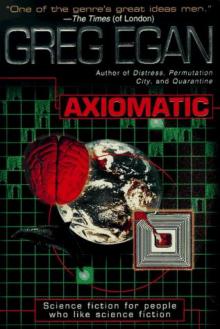 Axiomatic
Axiomatic![Anthology 2. Luminous [1998, 2010] Read online](http://i1.bookreadfree.com/i/03/18/anthology_2_luminous_1998_2010_preview.jpg) Anthology 2. Luminous [1998, 2010]
Anthology 2. Luminous [1998, 2010] Perihelion Summer
Perihelion Summer Luminous
Luminous